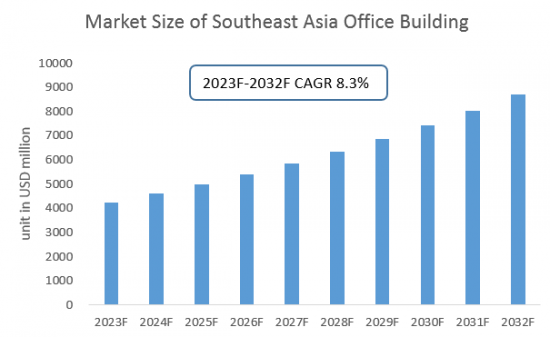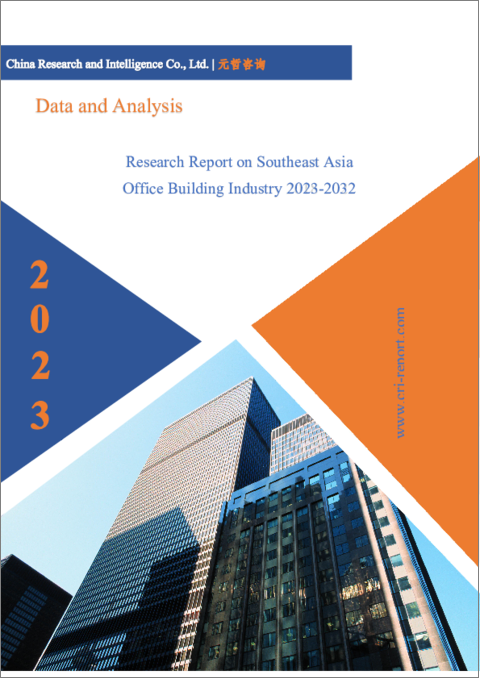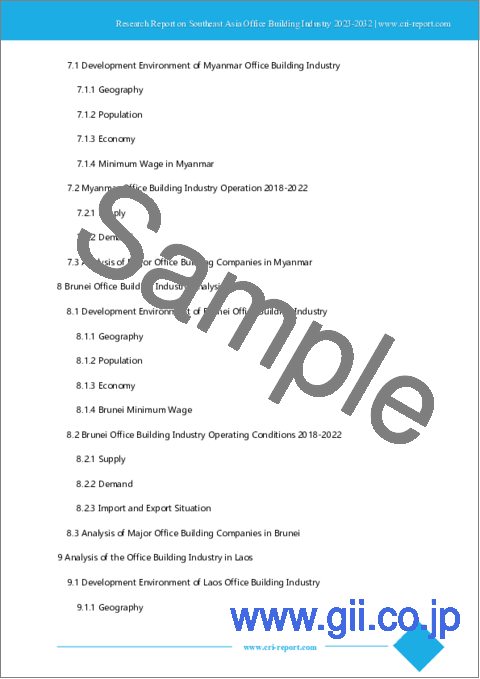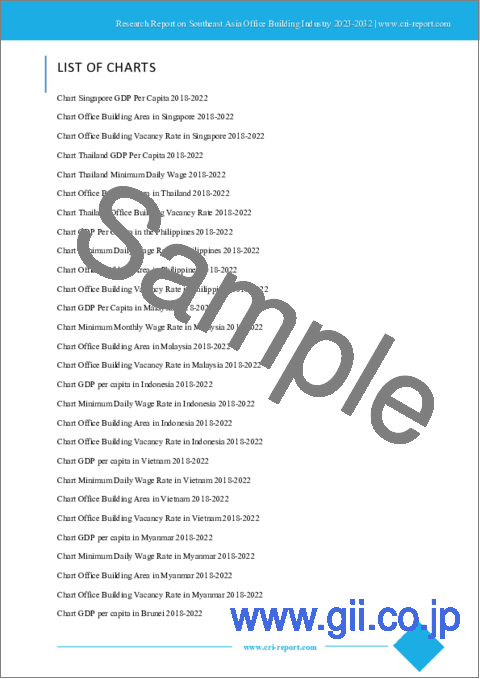|
|
市場調査レポート
商品コード
1231834
東南アジアのオフィスビル産業(2023年~2032年)Research Report on Southeast Asia Office Building Industry 2023-2032 |
||||||
| 東南アジアのオフィスビル産業(2023年~2032年) |
|
出版日: 2023年03月01日
発行: China Research and Intelligence
ページ情報: 英文 80 Pages
納期: 即日から翌営業日
|
- 全表示
- 概要
- 目次
東南アジアのは世界でもっとも急速に発展している地域のひとつであり、全体的な発展が力強く安定しているため、多くの投資家が東南アジアに集まり、企業数が年々増加しています。企業数の急増とオフィスなどの職場に対する需要の向上が、東南アジアのオフィスビル産業の発展を促進しています。
当レポートでは、東南アジアのオフィスビル産業について調査分析し、主な促進要因、課題と機会、COVID-19の影響などの情報を提供しています。
サンプルビュー

目次
第1章 シンガポールのオフィスビル産業の分析
- シンガポールのオフィスビル産業の開発環境
- 地域
- 人口
- 経済
- シンガポールの最低賃金
- シンガポールのオフィスビル産業の経営(2018年~2022年)
- 供給
- 要求
- シンガポールの主なオフィスビル企業の分析
第2章 タイのオフィスビル産業の分析
- タイのオフィスビル産業の開発環境
- 地域
- 人口
- 経済
- タイの最低賃金
- タイのオフィスビル産業の経営(2018年~2022年)
- 供給
- 要求
- タイの主なオフィスビル企業の分析
第3章 フィリピンのオフィスビル産業の分析
- フィリピンのオフィスビル産業の開発環境
- 地域
- 人口
- 経済
- フィリピンの最低賃金
- フィリピンのオフィスビル産業の経営(2018年~2022年)
- 供給
- 要求
- フィリピンの主なオフィスビル企業の分析
第4章 マレーシアのオフィスビル産業の分析
- マレーシアのオフィスビル産業の開発環境
- 地域
- 人口
- 経済
- マレーシアの最低賃金
- マレーシアのオフィスビル産業の経営(2018年~2022年)
- 供給
- 要求
- マレーシアの主なオフィスビル企業の分析
第5章 インドネシアのオフィスビル産業の分析
- インドネシアのオフィスビル産業の開発環境
- 地域
- 人口
- 経済
- インドネシアの最低賃金
- インドネシアのオフィスビル産業の経営(2018年~2022年)
- 供給
- 要求
- インドネシアの主なオフィスビル企業の分析
第6章 ベトナムのオフィスビル産業の分析
- ベトナムのオフィスビル産業の開発環境
- 地域
- 人口
- 経済
- ベトナムの最低賃金
- ベトナムのオフィスビル産業の経営(2018年~2022年)
- 供給
- 要求
- ベトナムの主なオフィスビル企業の分析
第7章 ミャンマーのオフィスビル産業の分析
- ミャンマーのオフィスビル産業の開発環境
- 地域
- 人口
- 経済
- ミャンマーの最低賃金
- ミャンマーのオフィスビル産業の経営(2018年~2022年)
- 供給
- 要求
- ミャンマーの主なオフィスビル企業の分析
第8章 ブルネイのオフィスビル産業の分析
- ブルネイのオフィスビル産業の開発環境
- 地域
- 人口
- 経済
- ブルネイの最低賃金
- ブルネイのオフィスビル産業の経営(2018年~2022年)
- 供給
- 要求
- 輸出入状況
- ブルネイの主なオフィスビル企業の分析
第9章 ラオスのオフィスビル産業の分析
- ラオスのオフィスビル産業の開発環境
- 地域
- 人口
- 経済
- ラオスの最低賃金
- ラオスのオフィスビル産業の経営(2018年~2022年)
- 供給
- 要求
- ラオスの主なオフィスビル企業の分析
第10章 カンボジアのオフィスビル産業の分析
- カンボジアのオフィスビル産業の開発環境
- 地域
- 人口
- 経済
- カンボジアの最低賃金
- カンボジアのオフィスビル産業の経営(2018年~2022年)
- 供給
- 要求
- カンボジアの主なオフィスビル企業の分析
第11章 東南アジアのオフィスビル産業の見通し(2023年~2032年)
- 東南アジアのオフィスビル産業の発展に影響を与える要因の分析
- 有利な要因
- 不利な要因
- 東南アジアのオフィスビルの産業規模の予測(2023年~2032年)
- 東南アジアのオフィスビル産業の需要の分析(2023年~2032年)
- オフィスビル産業に対するCOVID-19の流行の影響
Southeast Asia is one of the most rapidly developing regions in the world with strong and stable overall development, attracting numerous investors to Southeast Asia with the number of enterprises increasing year after year. In Vietnam, for example, the total number of enterprises nationwide reached 208,300 in 2022, up 30.3% year-on-year, with 148,500 newly registered enterprises and a total of 981,300 registered employees. The soaring number of enterprises and rising demand for offices and other workplaces are driving the development of the office building industry in Southeast Asia.
SAMPLE VIEW

Singapore, Jakarta (Indonesia), Ho Chi Minh City (Vietnam), Bangkok (Thailand) and Phnom Penh (Cambodia) have well-developed office buildings with low overall vacancy rates and stable or growing rents. As companies in various service industries such as information technology, finance and insurance enter Southeast Asia, local high-quality office building projects are gradually launched, attracting more investors to enter this market.
Southeast Asia in this report includes 10 countries: Singapore, Thailand, Philippines, Malaysia, Indonesia, Vietnam, Myanmar, Brunei, Laos and Cambodia. With a total population of over 600 million by the end of 2021, Southeast Asia has an overall economic growth rate higher than the global average and is one of the key drivers of future global economic growth.
According to CRI's analysis, the economic levels of the 10 Southeast Asian countries vary greatly, with Singapore being the only developed country with a per capita GDP of about US$73,000 in 2021. While Myanmar and Cambodia will have a GDP per capita of less than US$2,000 in 2021. The population and minimum wage levels of each country also vary greatly. Brunei, which has the smallest population, will have a total population of less than 500,000 people in 2021, while Indonesia, which has the largest population, will have a population of about 275 million people in 2021.
CRI expects the office building industry in Southeast Asia to maintain growth from 2023-2032, with both supply and demand for office buildings continuing to rise.
Topics covered:
- Southeast Asia Office Building Industry Status and Major Sources in 2018-2022
- What is the Impact of COVID-19 on Southeast Asia Office Building Industry?
- Which Companies are the Major Players in Southeast Asia Office Building Industry Market and What are their Competitive Benchmarks?
- Key Drivers and Market Opportunities in Southeast Asia Office Building Industry
- What are the Key Drivers, Challenges, and Opportunities for Southeast Asia Office Building Industry during 2023-2032?
- What is the Expected Revenue of Southeast Asia Office Building Industry during 2023-2032?
- What are the Strategies Adopted by the Key Players in the Market to Increase Their Market Share in the Industry?
- What are the Competitive Advantages of the Major Players in Southeast Asia Office Building Industry Market?
- Which Segment of Southeast Asia Office Building Industry is Expected to Dominate the Market in 2032?
- What are the Major Adverse Factors Facing Southeast Asia Office Building Industry?
Table of Contents
1 Singapore Office Building Industry Analysis
- 1.1 Singapore Office Building Industry Development Environment
- 1.1.1 Geography
- 1.1.2 Population
- 1.1.3 Economy
- 1.1.4 Minimum Wage in Singapore
- 1.2 Singapore Office Building Industry Operating Conditions 2018-2022
- 1.2.1 Supply
- 1.2.2 Demand
- 1.3 Analysis of Major Office Building Companies in Singapore
2 Analysis of the Office Building Industry in Thailand
- 2.1 Development Environment of Thailand Office Building Industry
- 2.1.1 Geography
- 2.1.2 Population
- 2.1.3 Economy
- 2.1.4 Minimum Wage in Thailand
- 2.2 Thailand Office Building Industry Operation 2018-2022
- 2.2.1 Supply
- 2.2.2 Demand
- 2.3 Analysis of Major Office Building Companies in Thailand
3 Analysis of the Office Building Industry in the Philippines
- 3.1 Development Environment of the Philippine Office Building Industry
- 3.1.1 Geography
- 3.1.2 Population
- 3.1.3 Economy
- 3.1.4 Minimum Wage in the Philippines
- 3.2 Philippine Office Building Industry Operation 2018-2022
- 3.2.1 Supply
- 3.2.2 Demand
- 3.3 Analysis of Major Office Building Companies in the Philippines
4 Analysis of the Office Building Industry in Malaysia
- 4.1 Development Environment of Malaysia Office Building Industry
- 4.1.1 Geography
- 4.1.2 Population
- 4.1.3 Economy
- 4.1.4 Minimum Wage in Malaysia
- 4.2 Malaysia Office Building Industry Operating Conditions 2018-2022
- 4.2.1 Supply
- 4.2.2 Demand
- 4.3 Analysis of Major Office Building Companies in Malaysia
5 Analysis of the Office Building Industry in Indonesia
- 5.1 Development Environment of Indonesia Office Building Industry
- 5.1.1 Geography
- 5.1.2 Population
- 5.1.3 Economy
- 5.1.4 Minimum Wage in Indonesia
- 5.2 Office Building Industry Operation in Indonesia 2018-2022
- 5.2.1 Supply
- 5.2.2 Demand
- 5.3 Analysis of Major Office Building Companies in Indonesia
6 Analysis of Vietnam's Office Building Industry
- 6.1 Development Environment of Vietnam Office Building Industry
- 6.1.1 Geography
- 6.1.2 Population
- 6.1.3 Economy
- 6.1.4 Minimum Wage in Vietnam
- 6.2 Vietnam Office Building Industry Operation 2018-2022
- 6.2.1 Supply
- 6.2.2 Demand
- 6.3 Analysis of Major Office Building Companies in Vietnam
7 Analysis of Myanmar's Office Building Industry
- 7.1 Development Environment of Myanmar Office Building Industry
- 7.1.1 Geography
- 7.1.2 Population
- 7.1.3 Economy
- 7.1.4 Minimum Wage in Myanmar
- 7.2 Myanmar Office Building Industry Operation 2018-2022
- 7.2.1 Supply
- 7.2.2 Demand
- 7.3 Analysis of Major Office Building Companies in Myanmar
8 Brunei Office Building Industry Analysis
- 8.1 Development Environment of Brunei Office Building Industry
- 8.1.1 Geography
- 8.1.2 Population
- 8.1.3 Economy
- 8.1.4 Brunei Minimum Wage
- 8.2 Brunei Office Building Industry Operating Conditions 2018-2022
- 8.2.1 Supply
- 8.2.2 Demand
- 8.2.3 Import and Export Situation
- 8.3 Analysis of Major Office Building Companies in Brunei
9 Analysis of the Office Building Industry in Laos
- 9.1 Development Environment of Laos Office Building Industry
- 9.1.1 Geography
- 9.1.2 Population
- 9.1.3 Economy
- 9.1.4 Minimum Wage in Laos
- 9.2 Operation of the Office Building Industry in Laos 2018-2022
- 9.2.1 Supply
- 9.2.2 Demand
- 9.3 Analysis of Major Office Building Companies in Laos
10 Analysis of Cambodia's Office Building Industry
- 10.1 Development Environment of Cambodia Office Building Industry
- 10.1.1 Geography
- 10.1.2 Population
- 10.1.3 Economy
- 10.1.4 Minimum Wage in Cambodia
- 10.2 Cambodia Office Building Industry Operation 2018-2022
- 10.2.1 Supply
- 10.2.2 Demand
- 10.3 Analysis of Major Office Building Companies in Cambodia
11 Southeast Asia Office Building Industry Outlook 2023-2032
- 11.1 Analysis of Factors Affecting the Development of Southeast Asia Office Building Industry
- 11.1.1 Favorable Factors
- 11.1.2 Unfavorable Factors
- 11.2 Southeast Asia Office Building Industry Size Forecast 2023-2032
- 11.3 Southeast Asia Office Building Industry Demand Analysis 2023-2032
- 11.4 Impact of COVID -19 Epidemic on Office Building Industry




